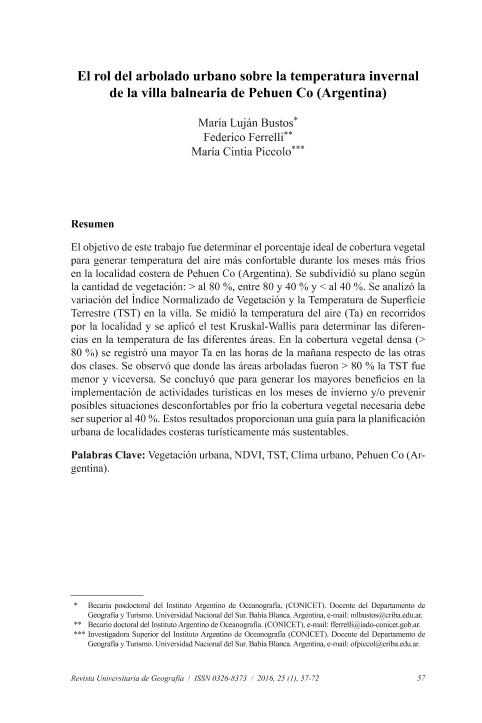Mostrar el registro sencillo del ítem
dc.contributor.author
Bustos, María Luján

dc.contributor.author
Ferrelli, Federico

dc.contributor.author
Piccolo, Maria Cintia

dc.date.available
2017-09-27T14:49:35Z
dc.date.issued
2016-01
dc.identifier.citation
Bustos, María Luján; Ferrelli, Federico; Piccolo, Maria Cintia; El rol del arbolado urbano sobre la temperatura invernal de la villa balnearia de Pehuén Co (Argentina); Universidad Nacional del Sur. Departamento de Geografía y Turismo; Revista Universitaria de Geografía; 25; 1; 1-2016; 57-72
dc.identifier.issn
0326-8373
dc.identifier.uri
http://hdl.handle.net/11336/25192
dc.description.abstract
El objetivo de este trabajo fue determinar el porcentaje ideal de cobertura vegetal para generar temperatura del aire más confortable durante los meses más fríos en la localidad costera de Pehuen Co (Argentina). Se subdividió su plano según la cantidad de vegetación: > al 80 %, entre 80 y 40 % y < al 40 %. Se analizó la variación del Índice Normalizado de Vegetación y la Temperatura de Superficie Terrestre (TST) en la villa. Se midió la temperatura del aire (Ta) en recorridos por la localidad y se aplicó el test Kruskal-Wallis para determinar las diferencias en la temperatura de las diferentes áreas. En la cobertura vegetal densa (> 80 %) se registró una mayor Ta en las horas de la mañana respecto de las otras dos clases. Se observó que donde las áreas arboladas fueron > 80 % la TST fue menor y viceversa. Se concluyó que para generar los mayores beneficios en la implementación de actividades turísticas en los meses de invierno y/o prevenir posibles situaciones desconfortables por frío la cobertura vegetal necesaria debe ser superior al 40 %. Estos resultados proporcionan una guía para la planificación urbana de localidades costeras turísticamente más sustentables.
dc.description.abstract
The aim of this study was to analyze the influence of vegetation on the spatial distribution of winter air temperature in order to determine the appropriate percentage of vegetation necessary to create a more comfortable environment during the coldest months in Pehuén Co (Argentina). The town was sub-divided into three regions according to the amount of vegetation: greater than 80%, between 40 and 80% and less than 40%. The Normalized Difference Vegetation Index (NDVI) and the Land Surface Temperature (LST) were applied. Air temperature data were analyzed using Kruskal-Wallis test in order to determine the relationship between air temperature and the vegetation coverage. The heavily vegetated region (>80%) presented an air temperature increase during the morning. The LST presented lower values in regions with more vegetation. It was concluded that the appropriate percentage of vegetation necessary to generate touristic activities in the winter months and/or prevent possible uncomfortably cold situations for people outdoors must be greater than 40%. These results provide a guide to urban planning in sustainable coastal towns.
dc.format
application/pdf
dc.language.iso
spa
dc.publisher
Universidad Nacional del Sur. Departamento de Geografía y Turismo
dc.rights
info:eu-repo/semantics/openAccess
dc.rights.uri
https://creativecommons.org/licenses/by-nc-sa/2.5/ar/
dc.subject
Vegetacion Urbana
dc.subject
Ndvi
dc.subject
Tst
dc.subject
Clima Urbano
dc.subject.classification
Estudios Urbanos

dc.subject.classification
Geografía Económica y Social

dc.subject.classification
CIENCIAS SOCIALES

dc.title
El rol del arbolado urbano sobre la temperatura invernal de la villa balnearia de Pehuén Co (Argentina)
dc.title
The influence of urban vegetation on winter temperature in Pehuen Co coastal town (Argentina)
dc.type
info:eu-repo/semantics/article
dc.type
info:ar-repo/semantics/artículo
dc.type
info:eu-repo/semantics/publishedVersion
dc.date.updated
2017-08-08T14:39:02Z
dc.journal.volume
25
dc.journal.number
1
dc.journal.pagination
57-72
dc.journal.pais
Argentina

dc.journal.ciudad
Bahía Blanca
dc.description.fil
Fil: Bustos, María Luján. Consejo Nacional de Investigaciones Científicas y Técnicas. Centro Científico Tecnológico Conicet - Bahía Blanca. Instituto Argentino de Oceanografía. Universidad Nacional del Sur. Instituto Argentino de Oceanografía; Argentina
dc.description.fil
Fil: Ferrelli, Federico. Consejo Nacional de Investigaciones Científicas y Técnicas. Centro Científico Tecnológico Conicet - Bahía Blanca. Instituto Argentino de Oceanografía. Universidad Nacional del Sur. Instituto Argentino de Oceanografía; Argentina
dc.description.fil
Fil: Piccolo, Maria Cintia. Consejo Nacional de Investigaciones Científicas y Técnicas. Centro Científico Tecnológico Conicet - Bahía Blanca. Instituto Argentino de Oceanografía. Universidad Nacional del Sur. Instituto Argentino de Oceanografía; Argentina
dc.journal.title
Revista Universitaria de Geografía
dc.relation.alternativeid
info:eu-repo/semantics/altIdentifier/url/http://ref.scielo.org/xmsrnx
Archivos asociados
